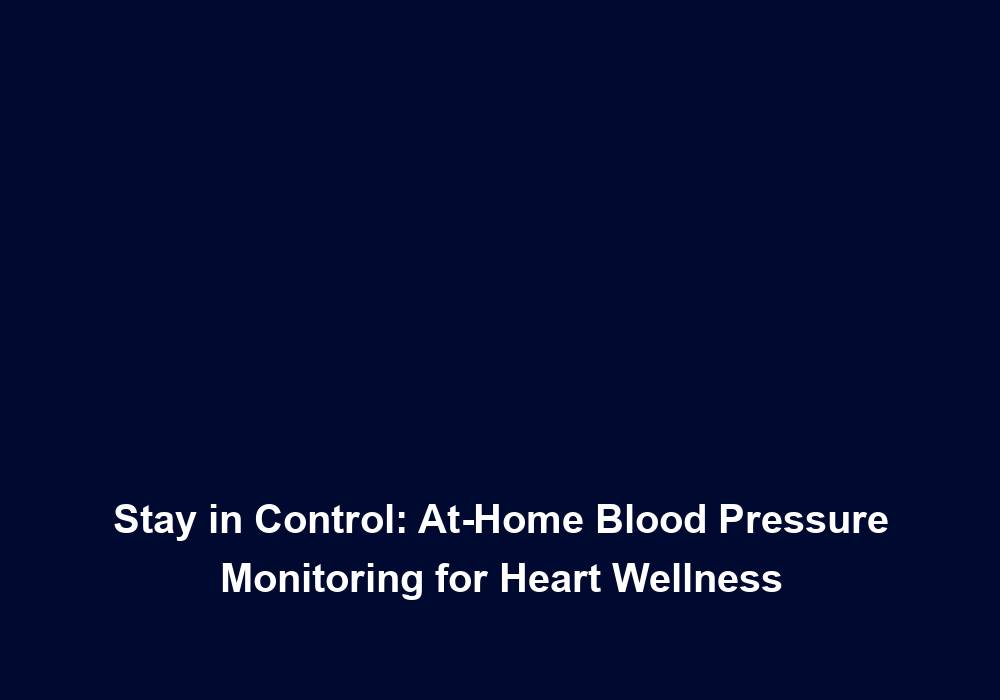Stay in Control: At-Home Blood Pressure Monitoring for Heart Wellness
Monitoring your blood pressure is crucial for maintaining optimal heart health. With the advancements in technology, at-home blood pressure monitoring has become increasingly accessible and convenient. By regularly checking and tracking your blood pressure in the comfort of your own home, you can take control of your heart wellness. In this article, we will explore the benefits of at-home blood pressure monitoring and provide you with the necessary information to make informed decisions about your heart health.
The Importance of Blood Pressure Monitoring
Blood pressure is a vital health indicator, measuring the force of blood against the walls of your arteries. It consists of two numbers: systolic pressure (the top number) and diastolic pressure (the bottom number). Healthy blood pressure levels typically range from 90/60 mmHg to 120/80 mmHg. Regular monitoring of your blood pressure allows you to detect any fluctuations or abnormalities early on, helping you prevent potential heart-related complications.
Blood pressure monitoring is essential because it helps identify any potential risks to your heart health. Fluctuations or abnormalities in blood pressure can indicate underlying medical conditions such as hypertension (high blood pressure) or hypotension (low blood pressure). By monitoring your blood pressure regularly, you can detect and address these issues early on, preventing them from developing into more severe complications.
Advantages of At-Home Blood Pressure Monitoring
- Convenience: Monitoring your blood pressure at home eliminates the need for frequent visits to healthcare facilities, saving you time and effort. With a portable blood pressure monitor, you can measure your blood pressure anytime and anywhere.
At-home blood pressure monitoring offers a convenient solution for individuals who may have busy schedules or limited access to healthcare facilities. Instead of having to make appointments and travel to a clinic, you can simply use a portable blood pressure monitor in the comfort of your own home. This convenience allows for more frequent and consistent monitoring, providing you with a better understanding of your blood pressure trends over time.
- Comfort: Some individuals may experience white coat syndrome, where their blood pressure elevates due to anxiety or stress caused by medical settings. At-home monitoring provides a more relaxed environment, allowing for more accurate readings.
White coat syndrome, also known as white coat hypertension, refers to the phenomenon of elevated blood pressure readings in a medical setting due to anxiety or stress. This can lead to inaccurate measurements and potentially unnecessary medical interventions. By monitoring your blood pressure at home, in a familiar and comfortable environment, you can reduce the impact of white coat syndrome and obtain more accurate readings.
- Personalized Tracking: By regularly monitoring your blood pressure at home, you can establish a comprehensive record of your readings over time. This data can be shared with your healthcare provider, enabling better analysis and personalized treatment plans.
Tracking your blood pressure readings over time provides valuable information for your healthcare provider to assess your heart health and tailor treatment plans accordingly. By sharing your at-home blood pressure records with your doctor, they can evaluate your progress, identify any patterns or trends, and make informed decisions about medication adjustments or lifestyle modifications.
- Early Detection: At-home monitoring allows for the early detection of potentially harmful fluctuations in blood pressure. By identifying any abnormalities promptly, you can seek medical attention and make lifestyle modifications before severe complications arise.
Regularly monitoring your blood pressure at home enables you to detect any significant changes or fluctuations early on. This early detection is crucial because it allows you to seek medical attention and make necessary lifestyle modifications before the development of severe complications. By addressing any abnormalities promptly, you can effectively manage your heart health and reduce the risk of long-term damage.
- Empowerment: Taking control of your heart health by monitoring your blood pressure at home empowers you to actively participate in your well-being. It promotes a proactive approach to managing your cardiovascular health and encourages positive lifestyle changes.
At-home blood pressure monitoring puts you in charge of your heart health. By taking the initiative to regularly measure and track your blood pressure, you become an active participant in your own well-being. This sense of empowerment motivates you to make positive lifestyle changes such as adopting a healthy diet, engaging in regular exercise, and managing stress effectively. By actively managing your cardiovascular health, you can improve your overall well-being and reduce the risk of heart-related complications.
Choosing the Right Blood Pressure Monitor
When selecting a blood pressure monitor for at-home use, consider the following factors:
- Accuracy: Look for monitors that are clinically validated and provide accurate readings. Ensure that the device has been tested and approved by regulatory authorities, such as the Food and Drug Administration (FDA).
Accuracy is a crucial factor when choosing a blood pressure monitor. To ensure reliable readings, opt for monitors that have been clinically validated and approved by regulatory authorities. Look for devices that have undergone rigorous testing and have proven accuracy in measuring blood pressure.
- Cuff Size: It is crucial to choose a monitor with the appropriate cuff size for your arm. Using an incorrectly sized cuff may lead to inaccurate readings. Measure the circumference of your upper arm before purchasing a device.
The cuff size of a blood pressure monitor is an important consideration for accurate measurements. Using a cuff that is too small or too large for your arm can result in inaccurate readings. To determine the appropriate cuff size, measure the circumference of your upper arm and choose a monitor that provides a cuff size range suitable for your measurements.
- Ease of Use: Opt for a blood pressure monitor that is user-friendly and easy to operate. Clear instructions, large display screens, and intuitive features can enhance your experience and minimize errors.
A user-friendly blood pressure monitor makes the monitoring process easier and more efficient. Look for devices that come with clear instructions and intuitive features. Large display screens with easy-to-read readings can help prevent errors or misinterpretations.
- Memory and Connectivity: Consider monitors that have built-in memory to store previous readings. Some advanced models can even connect to smartphone apps or other devices, allowing you to track and analyze your readings digitally.
Blood pressure monitors with built-in memory provide the convenience of storing previous readings for future reference. This feature allows you to track your blood pressure trends over time and share the data with your healthcare provider. Additionally, some monitors offer connectivity options, enabling you to sync your readings with smartphone apps or other devices for easy access and analysis.
- Validation: Check if the blood pressure monitor you are considering has been validated by independent organizations or has received positive reviews from users. This can help ensure the reliability and effectiveness of the device.
Before making a purchase, it is essential to research the validation and reviews of the blood pressure monitor. Look for devices that have been validated by independent organizations or have received positive feedback from users. This information can give you confidence in the reliability and effectiveness of the monitor.
Proper Technique for Blood Pressure Measurement
To obtain accurate blood pressure readings at home, it is essential to follow proper measurement techniques:
- Relax: Before measuring your blood pressure, take a few minutes to relax in a quiet environment. Sit comfortably with your back supported and feet flat on the floor.
To ensure accurate readings, create a calm and relaxed environment before measuring your blood pressure. Find a quiet space where you can sit comfortably with your back supported and feet flat on the floor. This relaxed state helps minimize any potential factors that could elevate your blood pressure, such as stress or physical exertion.
- Arm Position: Rest your arm on a flat surface, such as a table, with the cuff positioned at the same level as your heart. Ensure that the cuff is snug but not too tight.
Proper positioning of your arm is crucial for accurate blood pressure measurements. Rest your arm on a flat surface, such as a table, and position the cuff at the same level as your heart. Make sure the cuff is snug but not overly tight, as this can affect the accuracy of the readings.
- Avoid Distractions: Minimize distractions and avoid talking during the measurement. Remain still and silent to obtain accurate readings.
Distractions and talking during the blood pressure measurement can interfere with the accuracy of the readings. To obtain reliable results, minimize distractions and remain still and silent throughout the measurement process. This focused approach ensures that the readings reflect your true blood pressure levels.
- Multiple Readings: Take two or three consecutive readings, allowing a minute or two of rest between each measurement. Record all the readings.
Taking multiple readings allows for a more accurate assessment of your blood pressure. Blood pressure can vary from one moment to another, so taking two or three consecutive readings provides a more comprehensive picture of your overall blood pressure levels. Allow a minute or two of rest between each measurement to ensure accuracy. Record all the readings to share with your healthcare provider for analysis.
- Consistency: Measure your blood pressure at the same time each day, preferably in the morning before consuming any food or caffeine. This consistency helps in tracking any changes more effectively.
Consistency in blood pressure measurements is essential for tracking changes over time. Aim to measure your blood pressure at the same time each day, preferably in the morning before consuming any food or caffeine. This consistency eliminates potential variables that could affect your readings and allows for more accurate tracking of your blood pressure trends.
Interpreting Blood Pressure Readings
Understanding your blood pressure readings is crucial in assessing your heart health. Here is a general guideline for interpreting blood pressure readings:
- Normal: A blood pressure reading below 120/80 mmHg is considered within the normal range.
A blood pressure reading below 120/80 mmHg is generally considered within the normal range. This indicates that your blood pressure is at a healthy level, and there is no immediate cause for concern. However, it is still important to continue monitoring your blood pressure regularly to ensure it remains within the normal range.
- Elevated: Readings between 120-129/less than 80 mmHg indicate elevated blood pressure. Lifestyle modifications may be recommended to prevent further increases.
Elevated blood pressure falls between the range of 120-129/less than 80 mmHg. While not yet classified as hypertension, elevated blood pressure indicates a higher risk of developing high blood pressure in the future. Lifestyle modifications, such as adopting a healthy diet, increasing physical activity, and managing stress, may be recommended to prevent further increases in blood pressure.
- Hypertension Stage 1: Blood pressure readings ranging from 130-139/80-89 mmHg indicate stage 1 hypertension. Lifestyle changes and possible medication may be suggested.
Stage 1 hypertension is characterized by blood pressure readings ranging from 130-139/80-89 mmHg. At this stage, lifestyle changes, including dietary modifications, regular exercise, stress reduction, and weight management, are typically recommended. Depending on the individual’s overall health and risk factors, medication may also be prescribed to manage blood pressure.
- Hypertension Stage 2: Readings between 140-179/90-119 mmHg indicate stage 2 hypertension. Medical intervention, lifestyle modifications, and medication are typically prescribed.
Stage 2 hypertension is diagnosed when blood pressure readings consistently fall between 140-179/90-119 mmHg. At this stage, medical intervention is necessary to manage blood pressure. In addition to lifestyle modifications, such as a healthy diet and regular exercise, medication is often prescribed to help lower and control blood pressure.
- Hypertensive Crisis: Blood pressure readings exceeding 180/120 mmHg require immediate medical attention. Seek emergency medical care if you experience symptoms such as severe headache, chest pain, or shortness of breath.
A hypertensive crisis occurs when blood pressure readings exceed 180/120 mmHg. This is a severe condition that requires immediate medical attention. If you experience symptoms such as severe headache, chest pain, or shortness of breath alongside extremely high blood pressure, seek emergency medical care right away.
Conclusion
Monitoring your blood pressure at home is a proactive step towards maintaining optimal heart wellness. It provides convenience, personalized tracking, and early detection of any potential cardiovascular complications. By choosing the right blood pressure monitor and following proper measurement techniques, you can stay in control of your heart health. Remember to interpret your blood pressure readings accurately and consult with your healthcare provider for further guidance and support. Take charge of your heart wellness today and prioritize your overall well-being.







